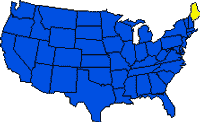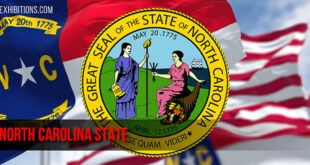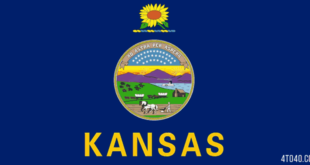 Maine, located in the extreme northeastern section of the United States, Maine is bordered by the Canadian provinces of Quebec on the northwest and New Brunswick on the north and east, by New Hampshire on the west, and by the Atlantic Ocean on the southeast and south. Although Maine is a relatively small state, it constitutes almost one-half of the area of New England.
Maine, located in the extreme northeastern section of the United States, Maine is bordered by the Canadian provinces of Quebec on the northwest and New Brunswick on the north and east, by New Hampshire on the west, and by the Atlantic Ocean on the southeast and south. Although Maine is a relatively small state, it constitutes almost one-half of the area of New England.
The state’s name is believed to be a contraction of the word mainland. Early explorers of the region described it as “The Main” to distinguish it from the offshore islands. Maine became the official name of the state when it joined the union in 1820. Residents of New England sometimes call Maine “Down East” because ships sailing north from Boston to Maine were sailing downwind.
About 90% of the state is covered with forests, and trees are a major resource for Maine’s paper, pulp, and wood industries. Farming–including the cultivation of the famous Maine potatoes–is also important to the economy, as is fishing. The state’s natural beauty, especially its rugged coast, attracts many tourists annually, making tourism an important source of income as well.
Land & Resources
 Much of Maine’s local topography is the result of glacial activity during the Pleistocene Epoch. The state can be divided into four physiographic regions that run from southwest to northeast: the coastal lowland, the interior hilly belt, the mountains, and the dissected upland.
Much of Maine’s local topography is the result of glacial activity during the Pleistocene Epoch. The state can be divided into four physiographic regions that run from southwest to northeast: the coastal lowland, the interior hilly belt, the mountains, and the dissected upland.
The coastal lowland, a narrow belt of low rolling land about 30 to 50 km (20 to 30 mi) wide, runs along the coast from Kittery to Eastport. This region is penetrated extensively by ocean inlets. In the BAR HARBOR and Camden areas, the interior hills reach the coast, so no lowlands are found in these areas. Cadillac Mountain (466 m/1,530 ft) on Mount Desert Island is the highest point on the Atlantic coast of the United States.
The interior hilly belt, which runs parallel to the coastal lowland, is a region of low hills averaging about 500 m (1,600 ft) in elevation. The region is narrow in the west but widens as it extends toward the New Brunswick border. The northern edge of the hilly belt is a line connecting Bridgton, Norway, Farmington, Guilford, Millinocket, and Houlton.
The mountain region of Maine is a portion of the APPALACHIAN MOUNTAINS known as the Longfellow Mountains. This discontinuous range runs from western Maine, north of Fryeburg, to just east of Mount Katahdin in the central part of the state. Fourteen peaks exceed 1,200 m (3,936 ft), including Maine’s highest point, Mount Katahdin, which rises to 1,605 m (5,267 ft). The dissected upland, which has an average elevation of about 350 m (1,140 ft), is located in most of Aroostook and northern Somerset, Piscataquis, and Penobscot counties.
Rivers and Lakes
In addition to approximately 5,000 rivers and streams, Maine also has more than 2,500 lakes and ponds. Most of the state is drained by south-flowing rivers, the larger ones from west to east being the Androscoggin, Kennebec, Penobscot, and Saint Croix. In the northern part of the state the Saint John River and its major tributaries, the Allagash and Aroostook, drain northward. The best-known lakes are Sebago, the Belgrades, Grands, Rangeleys, and the largest, Moosehead (303 sq km/117 sq mi). In addition, 26 other lakes in Maine exceed 23 sq km (9 sq mi).
Climate
Maine’s climate is characterized by rapid weather changes, large ranges of annual and diurnal temperatures, and great differences in the same season in different years. The basic weather pattern results from the state’s location in the path of frontal systems coming from the west. Differences in temperatures and precipitation exist between the north and the coast. The average annual temperature ranges from 4 deg C (40 deg F) in the north to 7 deg C (44 deg F) along the coast. The most marked differences are in the winter when northern Maine has January averages of -12 deg C (10 deg F) and the coast averages -7 deg C (20 deg F). Summer temperatures are more uniform over the state with July averages of about 20 deg C (68 deg F). Precipitation decreases from 1,170 mm (46 in) along the coast to 970 mm (38 in) in the north.
Historical Sites
Maine has a rich array of historic sites and landmarks, of which the oldest is the Old Gaol (a jail until 1860 but now a museum) in York, which dates to 1653. Revolutionary War sites include Fort Western (1754), where Benedict Arnold and his troops began their march on Quebec in 1775; and Burnham Tavern in Machias, where colonists met in 1775 to plot the capture of the British ship Margaretta. Other unique landmarks include Portland Head Light (1791), one of the oldest lighthouses in the United States, and the Wadsworth-Longfellow House in Portland, the boyhood home of Henry Wadsworth LONGFELLOW.
Tourism
One of the most important components of the state’s economy is tourism, which contributed more than $2 billion in 1987. In addition to its coastal and inland resorts, Maine has an abundance of wildlife that attracts hunters and sportsmen. State parks, as well as memorials, historical sites, and New England’s only national park–ACADIA NATIONAL PARK at Bar Harbor–also attract visitors.
History
Shell heaps left by early inhabitants may date from the 4th millennium BC. By the time European explorers reached Maine, the land was occupied by ABNAKI Indians.
Exploration and Settlement
Norse explorers may have reached Maine in about AD 1000, but the first European settlement was a short-lived one, established by the sieur de MONTS and Samuel de CHAMPLAIN in 1604. King James I of England included the region in his grant to the Plymouth Company, and another unsuccessful attempt was made to settle the region in 1607-08. The French established a settlement on Mount Desert Island in 1613 but were soon expelled by the English. Permanent English settlement began after 1622, when the Council for New England granted the territory between the Kennebec and Merrimack rivers to Sir Ferdinando GORGES and John MASON. In a division of the area in 1629, Gorges took the portion east of the Piscataqua River, which was chartered in 1639 as the “Province and Countie of Maine.” In 1652 the Massachusetts Bay Colony assumed jurisdiction over Maine, although the Gorges heirs disputed Massachusetts’ claim until 1677.
English settlement in Maine was hindered by repeated conflicts with the Indians and the French (see KING PHILIP’s WAR; FRENCH AND INDIAN WARS). Nonetheless, the granting of a new charter to Massachusetts in 1691, which reaffirmed its control of Maine, led to the establishment of local government and institutions modeled on those of Massachusetts. In the 18th century the foundations for Maine’s prosperous fishing, lumbering, and shipbuilding industries were laid.
The Revolution
In 1765, Maine joined Massachusetts in resisting the STAMP ACT. The SONS OF LIBERTY in Maine held their own “tea party” in York. Maine men were among the first to fight in the Revolutionary War; many coastal communities were attacked by the British, and the coastal town of Falmouth was destroyed. Although all areas east of the Penobscot River were occupied by the British, strong resistance was made by the colonists near Machiasport where the first naval battle of the Revolution took place on June 12, 1775, resulting in the capture of the British ship Margaretta. In 1775, Benedict ARNOLD led his unsuccessful expedition against Quebec through Maine. Other attempts to dislodge the British from eastern Maine were also unsuccessful, and so Britain retained control of the area throughout the war.
Statehood
After the United States won its independence, Maine grew in importance. More and more citizens of the state began to agitate for statehood, but it was not won until 1820, after eastern Maine had once again been occupied by the British during the WAR OF 1812. According to the MISSOURI COMPROMISE of 1820, Maine was admitted to the union as a free state balanced by Missouri as a slave state. Maine’s capital was at Portland but was moved (1832) to Augusta.
The new state grew rapidly in population and prosperity, largely through timber trade with Asia, Europe, and the West Indies, and as a center of shipbuilding, notably at BATH. Maine made important contributions of men and supplies to the Union during the Civil War. Over 73,000 Maine men served in the Union army, and about 7,000 lost their lives.
Following the Civil War, Maine’s population growth slowed significantly despite considerable immigration of English-speaking Canadians, French Canadians, Irish, and other Canadians, as well as attempts to attract European immigrants. Many coastal towns lost population while there was continued growth in the interior. Meanwhile, increased state and local government services such as improvement and expansion of roads, streets, lighting, fire protection, public education, and public libraries took place. Private enterprises expanded electricity networks, communication systems, public transportation, and manufacturing enterprises. The economy of Maine gradually shifted from agriculture, fishing, and lumbering, which peaked between 1865 and 1880, to manufacturing, which became the leading sector by 1900.
The developments in Maine in the 20th century mirrored those of the nation as a whole, although at a slower rate. There has been a continued shift from primary economic activities to manufacturing, with the most significant growth in trade, service, and government employment. Tourism grew tremendously after the 1930s, and several defense facilities were constructed during World War II, many of which were later phased out. The state’s shift from a predominantly farm economy to an industrial one was aided by the building of the Ripogenus Dam (1917), the Wyman Dam (1930), and the Maine Turnpike (1955). In 1962 the main ground station for the first communications satellite was completed at Andover.
During the later 20th century Maine’s population growth, jobs, income, and other elements of development lagged behind those in most of the rest of the nation. The state had lost many of its earlier advantages and depended upon the economic prosperity of the nation as a whole for its own well-being. The recent growth of the state’s population, however, as well as increasing emphasis on industry and tourism, suggest that Maine’s economic growth will continue at a faster rate.
Land
- Area: 91,653 sq km (35,387 sq mi); rank: 39th.
- Capital: Augusta (1990 pop., 21,325).
- Largest city: Portland (1990 pop., 64,358).
- Counties: 16.
- Elevations: highest–1,605 m (5,267 ft), at Mount Katahdin; lowest–sea level, at Atlantic Ocean coast.
 Kids Portal For Parents India Kids Network
Kids Portal For Parents India Kids Network









